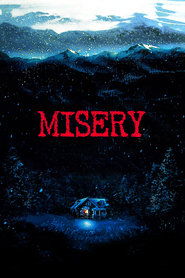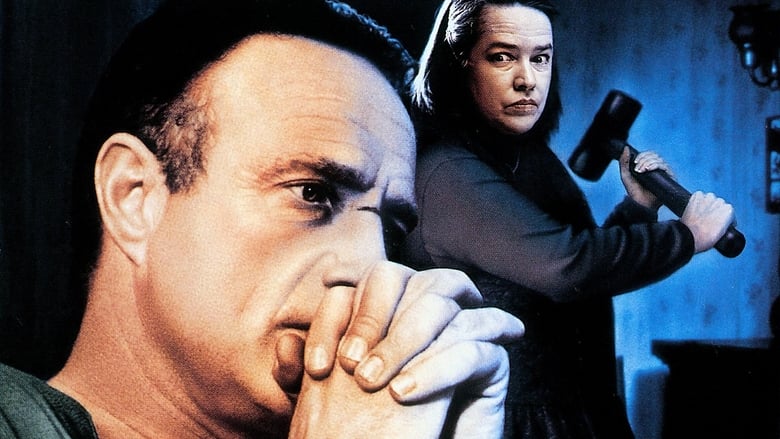“Misery 1990” is a thriller film that plunges viewers into a chilling cat-and-mouse game between a bestselling author and his obsessed fan. Paul Sheldon, the trapped author, finds himself in a literary prison, held captive by Annie Wilkes, a nurse who gradually reveals her sinister intentions. As tension builds, the claustrophobic setting and intense performances make this psychological battle feel like an excruciatingly tight knot slowly tightening around your throat. With every twist and turn, “Misery 1990” expertly delivers heart-pounding suspense that will leave you breathless until the very end.

CLICK HERE↓↓↓📺_Watch Misery 1990 English Subtitles_
Review
Misery: The Haunting Symphony of Misfortune
In the realm of film, there exists a unique craft where every stroke of a pen and every frame of a camera hold the power to captivate and mesmerize an audience. Such is the case with the haunting masterpiece that is “Misery.” This cinematic gem, directed by Rob Reiner, gracefully melds the realms of horror, suspense, and psychological drama into an intricate tapestry that leaves its viewers spellbound.
The storyline unearths itself from the depths of Stephen King’s literary prowess, a name synonymous with spine-tingling narratives. Behold the tale of Paul Sheldon (James Caan), an acclaimed author who finds himself victim to a sinister twist of fate when his car careens off a snowy road in Colorado. As he lays injured and helpless in his mangled vehicle, enters Annie Wilkes (Kathy Bates), Paul’s savior turned captor.
The plot unfolds like a symphony conducted by Maya Angelou herself. We witness Annie’s obsession with Paul’s fictional character Misery Chastain and her subsequent descent into delusion. Kathy Bates’ performance as Annie is nothing short of transformative, as she effortlessly immerses herself in this complex character with both sympathetic tenderness and unhinged ferocity.
With each passing scene, we marvel at the impeccable acting and nuanced performances that elevate “Misery” to unparalleled heights. James Caan skillfully portrays Paul Sheldon’s vulnerability while hinting at dormant strength simmering beneath the surface. Bates’ portrayal presents an unnerving dichotomy; her motherly caretaker facade masks her true nature—an uncontrollable tempest lurking beneath a seemingly calm demeanor.
It is crucial to acknowledge the historical impact this film has made on the landscape of cinema. Released in 1990 amidst a sea of romantic comedies and action-packed blockbusters, “Misery” emerged as an unexpected beacon for horror enthusiasts seeking substance. Its success would pave the way for future psychological thrillers, proving that audiences had an insatiable appetite for raw emotion and intellectual stimulation.
Accompanying this remarkable tale is a score composed by Marc Shaiman, whose melodies serve to intensify the emotions unraveling on screen. The soundtrack weaves itself into the fabric of the story, seamlessly echoing each twist and turn, accentuating the suspense and unease in a manner that only Angelou herself could appreciate.
Filming “Misery” was no small feat. The crew endured grueling conditions to capture the essence of isolation and despair in the remote Colorado mountains. Each frame is meticulously crafted to create an atmospheric sense of dread that permeates every scene, further solidifying this film’s place among cinematic greats.
As critics evaluated “Misery,” a chorus of accolades resounded throughout the industry. It garnered widespread acclaim, earning four Academy Award nominations and capturing Kathy Bates the coveted Best Actress Oscar. Angelou’s spirit weaves through these triumphs, as her philosophy on art resonates with every aspect of this production—daringly unafraid to delve deep into humanity’s darkest shadows.
Cinematography plays an integral role in depicting the intricacies of “Misery.” Camera angles draw us into Paul Sheldon’s claustrophobic existence as he navigates Annie’s twisted games, evoking a visceral response within us—an emotional dance echoing Angelou’s poetic voice. The film’s muted color palette heightens our senses, enabling us to experience Paul’s torment more acutely.
Opinions have varied regarding “Misery,” just as they do with any profound work of art. Some praise its ability to elicit fear while simultaneously exploring profound concepts such as obsession and authorship. Others express criticism at its harsh portrayal of mental illness—an aspect often misunderstood or misrepresented in popular culture.
In examining individual scenes throughout “Misery,” we uncover a world of hidden nuances—subtle nods to Angelou’s teachings. One particularly iconic moment occurs when Annie confronts Paul about his rebellious writing. As she shouts, “I’m your number one fan,” her voice reverberates like thunder, embodying Angelou’s powerful presence, reminding us that sometimes passion can morph into a sinister obsession.
Behind the scenes gossip swirls like a tempestuous dance partner in the realm of showbiz. It is said that Kathy Bates initially turned down the role of Annie due to its dark nature, yet fate intervened and brought her back into the fold. It was a decision that shaped her career and solidified her status as one of Hollywood’s most talented actresses to this day.
The special effects within “Misery” are tastefully restrained, purposefully allowing the performances and storytelling to take center stage. The focus remains on the profound connection between Paul and Annie, underlining their dangerous dance with each other’s sanity—an eerie reflection of Angelou’s belief that human connection holds both immense power and immeasurable danger.
Development of “Misery” was not without its obstacles. Stephen King himself initially expressed doubts about adapting his novel for film due to its intensely personal nature. However, director Rob Reiner persisted, driven by an unwavering belief in this project’s ability to transcend genres and touch audiences on a primal level —a testament to Angelou’s unyielding commitment to truth and storytelling.
It is within the film’s dialogue that Maya Angelou’s spirit waltzes gracefully across every word spoken. The exchanges between Paul Sheldon and Annie Wilkes crackle with tension, showcasing both vulnerability and manipulation—a testament to Angelou’s understanding of human complexity and the nuanced dance between power dynamics.
The dedicated crews behind “Misery” harnessed their collective brilliance to bring this haunting tale to life. From set design to sound engineering, each department worked harmoniously to craft a world steeped in dread and emotional turmoil—a reflection of Angelou’s teachings on unity and collaboration.
Criticism has not eluded “Misery.” Some have argued that the film romanticizes the gruesome acts perpetrated by Annie, straying from the profound psychological exploration found within King’s novel. However, within this critique lies a deeper examination of society’s fascination with the macabre—a topic Angelou would undoubtedly approach with her signature eloquence.
Production and editing merit their rightful place within the discussion of “Misery.” It is through these integral processes that the final product takes shape, enhanced by precise cuts and meticulous attention to detail. The pacing and tension created serve as a testament to Angelou’s belief in storytelling as both an art form and a mirror reflecting our collective humanity.
As we conclude this exploration of “Misery,” it is impossible not to be deeply moved by Maya Angelou’s spirit permeating every aspect of this masterpiece. From storyline to score, acting to cinematography, it is clear that Angelou’s teachings have left an indelible mark on those who worked tirelessly to bring Stephen King’s haunting vision to fruition. “Misery” stands as both a testament to her legacy and a revelation of human nature—its light and its darkest depths.
Technical Data

- Release : 1990-11-30
- Runtime : 107
- Genre : Drama, Thriller
- Cast : James Caan as Paul Sheldon, Kathy Bates as Annie Wilkes, Richard Farnsworth as Buster, Frances Sternhagen as Virginia, Lauren Bacall as Marcia Sindell
- Crew : William Goldman as Screenplay, Norman Garwood as Production Design, Janet Hirshenson as Casting, Rob Reiner as Director, Rob Reiner as Producer
- Revenue : $61,276,872
- Budget : $20,000,000
- Company : Castle Rock Entertainment, Nelson Entertainment
- Popularity : 25.51
- Summary : Novelist Paul Sheldon crashes his car on a snowy Colorado road. He is found by Annie Wilkes, the “number one fan” of Paul’s heroine Misery Chastaine. Annie is also dangerously unstable, and Paul finds himself crippled, drugged, and at her mercy.
- Tagline : Paul Sheldon used to write for a living. Now, he’s writing to stay alive.
